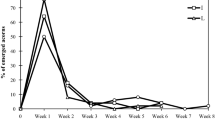Abstract
Araucaria angustifolia exhibits cryptogeal germination, where the root–hypocotyl axis emerges first and penetrates into the soil. In Araucaria bidwillii, the whole process of transferring reserves from the seed to the seedling takes place before shoot emergence, and there is a major storage of these reserves in the underground hypocotyl, which assumes a tuberous form. In A. angustifolia, the shoot emerges before seed reserves are depleted. Though it does not grow like a tuber, the hypocotyl of A. angustifolia grows thicker than the adjacent taproot during initial growth, and we hypothesize that it may act as a major sink for seed reserves during this stage. The study tests this hypothesis by evaluating changes in the mass of different plant parts during initial growth. Four harvests were conducted during a ~6-month period to compare the dry mass of different fractions (attached seed, seedling, its shoot and root and the hypocotyl) of seedlings growing under darkness and high light. While seed reserves were still being depleted, the hypocotyl mass showed an initial increase and then a reduction. This was more abrupt when light was available. After seed mass had stabilized, the mass of the hypocotyl continued to decrease in the dark-grown seedlings, but showed a second increase in the light-grown ones. Results confirm the hypothesis that the hypocotyl represents a major sink for the seed reserves of A. angustifolia, acting as an underground storage structure for the growing seedling. Its reserves seem to be important for sustaining initial shoot growth and might also act as a storage sink for photosynthates.




Similar content being viewed by others
References
Burrows GE, Stockey RA (1994) The developmental anatomy of cryptogeal germination in Bunya pine (Araucaria bidwillii). Int J Plant Sci 155:519–537
Burrows GE, Boag TS, Stockey RA (1992) A morphological investigation of the unusual cryptogeal germination strategy of Bunya pine (Araucaria bidwillii)—an Australian rain forest conifer. Int J Plant Sci 153:503–512
Cardemil L, Reinero A (1982) Changes of Araucaria araucana seed reserves during germination and early seedling growth. Can J Bot 60:1629–1638
Duarte LS, Dillenburg LR, Rosa LMG (2002) Assessing the role of light availability in the regeneration of Araucaria angustifolia (Araucariaceae). Aust J Bot 50:741–751
Duarte LS, Santos MMG, Hartz SM, Pillar VD (2006) Role of nurse plants in Araucaria Forest expansion over grassland in south Brazil. Austral Ecol 31:520–528
Farjon A (2006) Araucaria angustifolia. In: 2006 IUCN red list of threatened species. IUCN. http://www.iucnredlist.org. Accessed 07 Nov 2007
Ferreira AG, Handro W (1979) Aspects of seed germination in Araucaria angustifolia (Bert.) O.Ktze. Rev Bras Bot 2:7–13
Ferreira AG, Dietrich SMC, Handro W (1979) Changes in the metabolism of Araucaria angustifolia during the early phases of germination and growth. Rev Bras Bot 2:67–71
Foster AS, Janson CH (1985) The relationship between seed mass and establishment conditions in tropical woody plants. Ecology 66:773–780
Franco AMS, Dillenburg LRD (2007) Ajustes morfológicos e fisiológicos em plantas jovens de Araucaria angustifolia (Bertol.) Kuntze em resposta ao sombreamento. Hoehnea 34:135–144
Furlanetto DA, Nimer E, Justus JO, Moser JM, Cardoso MFTC, Herrmann MLP, Mesquita OJ, Kaul PFT, Leite PF, Klein RM, Rosa RO, Silva ST, Bezerra VMAC (1990) Geografia do Brasil. Região Sul, vol 2. IBGE, Rio de Janeiro
Garwood NC (1996) Functional morphology of tropical tree seedlings. In: Swaine MD (ed) The ecology of tropical forest tree seedlings. UNESCO, Paris, pp 59–125
Hemsley WB (1901–1902) Germinating seeds of Araucaria bidwillii. Proc Linn Soc London 114:1–2
Ichie T, Ninomiya I, Ogino K (2001) Utilization of seed reserves during germination and early seedling growth by Dryobalanops lanceolata (Dipeterocarpaceae). J Trop Ecol 17:371–378
Kennedy PG, Hausmann NJ, Wenk EH, Dawson TE (2004) The importance of seed reserves for seedling performance: an integrated approach using morphological, physiological, and stable isotope techniques. Oecologia 141:547–554
Kitajima K (1996) Cotyledon functional morphology, patterns of seed reserve utilization and regeneration niches of tropical tree seedlings. In: Swaine MD (ed) The ecology of tropical forest tree seedlings. UNESCO, Paris, pp 193–210
Kitajima K, Fenner M (2000) Ecology of seedling regeneration. In: Fenner M (ed) Seeds: the ecology of regeneration in plant communities, 2nd edn. CAB International, Wallingford, pp 331–359
Leishman MR, Wright IJ, Moles AT, Westoby M (2000) The evolutionary ecology of seed size. In: Fenner M (ed) Seeds: the ecology of regeneration in plant communities, vol 2. CAB International, Wallingford, pp 31–57
Panza V, Láinez V, Maroder H, Prego I, Maldonado S (2002) Storage reserves and cellular water in mature seeds of Araucaria angustifolia. Bot J Linn Soc 140:273–281
Paz H, Mazer SJ, Martínez-Ramos M (1999) Seed mass, seedling emergence, and environmental factors in seven rain forest Phychotria (Rubiaceae). Ecology 80:1594–1606
Pereira F, Ganade G (2008) Spread of a Brazilian keystone-species in a landscape mosaic. For Ecol Manage 225:1654–1683
Poorter L, Rose SA (2005) Light-dependent changes in the relationship between seed mass and seedling traits: a meta-analysis for rain forest tree species. Oecologia 142:378–387
Quero JL, Villar R, Marañón T, Zamora R, Poorter L (2007) Seed mass effect in four Mediterranean Quercus species (Fagaceae) growing in contrasting light environments. Am J Bot 94:1795–1803
Walters MB, Reich PB (1999) Low light carbon balance and shade tolerance in the seedlings of woody plants: do winter deciduous and broad-leaved evergreen species differ? New Phytol 143:143–154
Westoby M, Falster DS, Moles AT, Vesk PA, Wright IJ (2002) Plant ecological strategies: some leading dimensions of variation between species. Ann Rev Ecol Syst 33:125–159
Acknowledgments
We thank Dr. Renato Borges da Silveira, who offered us the greenhouse space for conducting this study. We also thank the National Council for Scientific and Technological Development (CNPq/Brazil) for the fellowships awarded to the authors.
Author information
Authors and Affiliations
Corresponding author
Additional information
Communicated by T. Grams.
Rights and permissions
About this article
Cite this article
Dillenburg, L.R., Rosa, L.M.G. & Mósena, M. Hypocotyl of seedlings of the large-seeded species Araucaria angustifolia: an important underground sink of the seed reserves. Trees 24, 705–711 (2010). https://doi.org/10.1007/s00468-010-0440-y
Received:
Revised:
Accepted:
Published:
Issue Date:
DOI: https://doi.org/10.1007/s00468-010-0440-y




